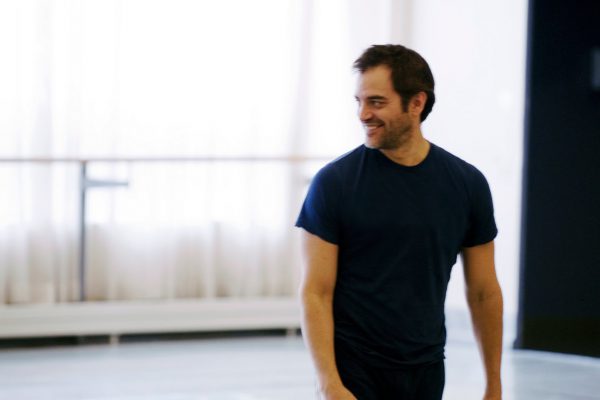A ProArteDanza opening always has a buzz-y kind of glamour — people dress up, they talk about the work, clearly excited to be there. Some of the city’s finest classical and contemporary dancers grace the stage; the rest can be found in the audience along with students and hip dance fans of all stripes. Former National Ballet of Canada (NBoC) soloist Roberto Campanella really filled a gap in the Toronto cultural dancescape when he founded the company in 2004.
Designed to marry the rigour and technical virtuosity of classical ballet to the creativity and freedom of contemporary dance as well as provide opportunities for Toronto’s many fine independent artists and choreographers, ProArteDanza’s identity is summed up by one carefully chosen word: passion; it graces all the company’s marketing and publicity materials. And it’s only passion that could drive such an ambitious project within our national climate of chronic under-funding for the arts. International in scope (because at the highest levels of achievement the community of dance is a global one), the company changes personnel from season to season, commissioning new work and casting accordingly.
The core of the 2006 season consisted of three new works (two by Campanella and one by ProArteDanza’s artistic associate Robert Glumbek) bracketed by a couple of works created for Ballett Manheim (a German company rife with dancing Canadians): “Subsistence” also by Robert Glumbek and “Bloodgroove” by Ballett Mannheim Artistic Director Kevin O’Day.
Glumbek’s “Subsistence” is a group work “inspired by memories of Poland before Glasnost”. Performed to a score by Henryk Gorecki (the “Quasi Una Fantasia”), the dance is predictably gloomy; the choreography is punctuated with leitmotif poses depicting dejection, hunger (stomach holding, fingers to mouth) wariness (finger to lips — the universal sign for watch what you say), misery (a silent scream) and occasionally, defiance (the classic pose of the pugilist — dukes up). Though far too long for the way the material is treated here — the story of oppression and human suffering can fill volumes yet find physical expression in the crook of an arm or the set of a back — “Subsistence” has a bleak elegance to it. The ensemble work is less memorable than the solos — especially the one performed by Johanna Bergfeldt, who has to be one of the most riveting performers in Toronto these days. And there are a few awkward transitionsbetween scenes where the performers seem to be struggling to find the pace. The work suffers as well from the occasional descent into cliché: the final scene where Bergfeldt is propelled up and over a wall at back of the stage is one example. But there are also very powerful moments where Glumbek and his cast capture the light that can shine within the heart of the darkest human condition.
Of the three new works on the program, the most memorable for me was “the calm below”, a solo by Campanella, performed by the magnificent NBoC star Guillaume Coté. Yet, I can’t remember any of the steps between the beginning and end scenes of Coté noodling tunefully at the keyboard of a grand piano in one corner of the stage. What I will never forget is the experience of watching a master mover at the peak of his power, the incredible and thoroughly tangible thrill of watching technical rigour mesh with animal physicality. With dancers like Coté, Glumbek and Bergfeldt onstage, ProArteDanza could get away with almost anything, choreographically speaking. Let’s not dwell on the fact that we all know that’s not good enough in the grand scheme of things.
This middle section of the evening, programmed with shorter works, also featured a duet by Glumbek called “Still” that was commissioned by ProArteDanza. Performed by Glumbek and Bergfeldt, the piece is a fun, fast, aggressive riff on coupledom — not deep but thoroughly enjoyable and technically challenging for these fantastic performers. Campanella’s “Current, Surrender”, an ensemble work performed by Bergfeldt, Danielle Denichaud, Stephanie Hutchison, Sarah Robichaud, Anisa Tejpar and Meredith Woodley, was not quite so fun. Though many in the audience were entranced by the expansive movement, occasional pointe work and complex patterning on display, I found Campanella’s nautical reverie (a poem by Walt Whitman called “Two Rivulets” was included in the program notes) a bit kitschy with its touches of rolling fog and de-bodied legs of the dancers jutting from the wings. That’s not a bad thing per se, it’s just not my thing.
The kitsch factor re-appeared in O’Day’s “Bloodgroove” — times ten. But here it seemed a more organically integrated feature if that’s possible. O’Day’s theatrical tribute to a particular type of American modern/jazz dance as embodied by Gregory Hines, to whom the piece is dedicated, was born of Broadway, with jazz fingers and comic mugging in full effect. The ghosts of “An American in Paris” haunt these fast and furious proceedings. Performed by an ensemble of ten to a neo-Piazzola score by John King, “Bloodgroove” pleased the crowd but left this individual audience member wanting more.
More clarity, more rigour. It’s an apt analogy for the company itself. ProArteDanza has the passion part nailed. It’s to be hoped that they can find the resources to kick it all up a notch. They need more money, more time to rehearse and a more pointed approach to choosing repertoire in order to create a truly world class contemporary ballet company.
Tagged: Ballet, Contemporary, Performance, ON , Toronto




